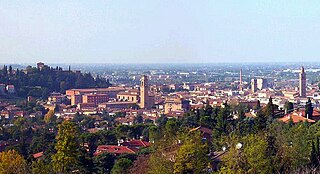
Cesena is a city and comune in the Emilia-Romagna region of Italy, served by Autostrada A14, and located near the Apennine Mountains, about 15 kilometres from the Adriatic Sea. The total population is 97,137.

The Rubicon is a shallow river in northeastern Italy, just south of Cesena and north of Rimini. It was known as Fiumicino until 1933, when it was identified with the ancient river Rubicon, famously crossed by Julius Caesar in 49 BCE.

The Savio is a river in the Emilia-Romagna region of northern Italy. Its source is in the province of Forlì-Cesena near Montecoronaro on Mount Castelvecchio which is near the western side of Mount Fumaiolo. The source is at an elevation of 1,126 metres (3,694 ft) and is marked by an iron monument. A wolf and the rings of the "caveja" are on this monument. The river flows near Verghereto and Bagno di Romagna as it winds through the mountains before entering Lago di Quarto. After leaving the lake, the river flows northeast near Sarsina and Mercato Saraceno before flowing north. The river winds for 96 kilometres (60 mi) along the valley. Its natural track has been preserved relatively well and, in the territory of Cesena, it shows an environment which is one of the purest of the whole Romagna. North of Cesena, the river crossed the border into the province of Ravenna. After a total course of 126 kilometres (78 mi) the river enters the Adriatic Sea north of Cervia by Lido di Classe and Lido di Savio.
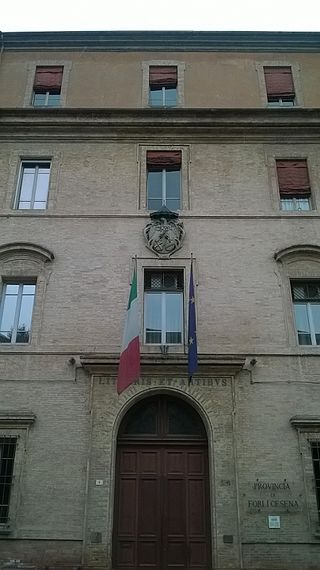
The province of Forlì-Cesena is a province in the Emilia–Romagna region of Italy. Its capital is the city of Forlì. The province has a population of 394,273 as of 2016 over an area of 2,378.4 square kilometres (918.3 sq mi). It contains 30 comuni and the provincial president is Davide Drei. Although located close to the independent Republic of San Marino, Forlì-Cesena does not share a land border with the sovereign state.

The province of Ravenna is a province in the Emilia-Romagna region of Italy. Its capital is the city of Ravenna. As of 2015, it has a population of 391,997 inhabitants over an area of 1,859.44 square kilometres (717.93 sq mi), giving it a population density of 210.81 inhabitants per square kilometre. Its provincial president is Claudio Casadio.
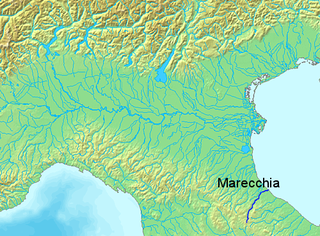
The Marecchia is a river in eastern Italy. In ancient times it was known as the Ariminus which was from the Greek Aríminos. The source of the river is near Monte dei Frati which is east of Pieve Santo Stefano and southwest of Badia Tedalda in the Province of Arezzo in Tuscany. It flows northeast into the Province of Pesaro and Urbino in the Marche and is the only river that runs through Montefeltro. While flowing through Montefeltro, the river flows through the exclave Santa Sofia Marecchia, which belongs to Badia Tedalda. The river then flows past Sant'Agata Feltria and Novafeltria before crossing into the Province of Rimini in Emilia–Romagna. At Torello, part of the commune of San Leo, it flows 1 km west of the Sammarinese territory Acquaviva and the San Marino River flows into it, but the Marecchia does not touch the San Marino border. Finally, the river flows past Verucchio and Santarcangelo di Romagna before flowing into the Adriatic Sea near Rimini.

The Agri is a river in the Basilicata region of southern Italy. In ancient times it was known as Aciris. The source of the river is in the Lucan Apennines north of Monte Volturino and west of Calvello in the province of Potenza. It is near the source of the Basento. The river flows south near Paterno before curving southeast. It flows near Tramutola, Viggiano, and Grumento Nova before entering a lake. After exiting the lake, the river flows eastward near Armento, Missanello, Aliano, and Sant'Arcangelo. A right tributary, the Racanello, enters the river in this area. The river forms the border between the province of Potenza and the province of Matera for part of this area of the river. It flows into a small lake before entering the province of Matera. The river flows for a short distance before entering Lago di Gannano. After exiting the lake, the river flows southeast near Tursi, Montalbano Jonico, and Scanzano Jonico before flowing into the Gulf of Taranto near Policoro.

The Basento is a river in the Basilicata region of southern Italy. It rises at Monte Arioso in the southern Apennine Mountains, southwest of Potenza in the province of Potenza. The river flows northeast near Pignola and Potenza before curving east near Vaglio Basilicata. It curves southeast and flows near Brindisi Montagna, Trivigno, and Albano di Lucania. A right tributary coming from Lago di Ponte Fontanelle flows into the river in this area. The river forms the border between the province of Potenza and the province of Matera for a short distance before flowing into the province of Matera. It flows eastward near Tricarico, Calciano, and Grassano before curving southeast. The river flows near Grottole, Miglionico, Pomarico, Ferrandina, and Monte Finese before curving eastward. It flows near Pisticci and Bernalda before flowing into the Gulf of Taranto, which is part of the Ionian Sea, near Metaponto. The main city on the Basento is Potenza, the capital of Basilicata.

Premilcuore is a comune (municipality) in the Province of Forlì-Cesena in the Italian region Emilia-Romagna, located about 70 kilometres (43 mi) southeast of Bologna and about 35 kilometres (22 mi) southwest of Forlì.

The Santerno is a river in Romagna in northern Italy. It is a major tributary of the river Reno. In Roman times, it was known as the Vatrenus, although, in the Tabula Peutingeriana, it was already identified as the Santernus.

The Tronto is a 115-kilometre (71 mi) long Italian river that arises at Monti della Laga and ends in the Adriatic Sea at Porto d'Ascoli, San Benedetto del Tronto. It traverses the Lazio, Marche, and Abruzzo regions of Italy.

Piadina or piada is a thin Italian flatbread, typically prepared in the Romagna historical region. It is usually made with white flour, lard or olive oil, salt and water. The dough was traditionally cooked on a terracotta dish, although nowadays flat pans or electric griddles are commonly used.

The Foglia is the northernmost river of the Marche region of Italy. In ancient times it was known as Pisaurus, as it debouched into the Adriatic Sea at Pisaurum. It was also known as the Isaurus. The source of the river is west of Sestino in the province of Arezzo in the Umbrian-Marchean Apennines mountains. It flows east through an extension of the province of Pesaro e Urbino and then back into Arezzo before forming the border between Arezzo and Pesaro e Urbino. The river then flows into the province of Pesaro e Urbino past Piandimeleto and curves northeast and flows past Sassocorvaro before curving east again. The river meanders south of Montecalvo in Foglia before curving northeast and flowing near Colbordolo, Saludecio, Sant'Angelo in Lizzola, Montecchio, Montelabbate and Tavullia before entering the Adriatic Sea near Pesaro.

The Bidente-Ronco is a river in the Emilia-Romagna region of Italy. The first portion of the river is called the Bidente. Once the river passes under the Ponte dei Veneziani in Meldola, the river is called the Ronco. The source of the river is near the border between the province of Forlì-Cesena, the province of Arezzo, and the province of Florence in the Foreste Casentinesi, Monte Falterona, Campigna National Park. The river flows northeast through the mountains in the province of Forlì-Cesena and flows near Santa Sofia, Galeata, Civitella di Romagna and Meldola. Beyond Meldola, the river flows north near Bertinoro, Forlimpopoli, and Forlì before crossing the border into the province of Ravenna. The river flows northeast until it joins the Montone south of Ravenna, and the resulting river is known as the Uniti. The Battle of Ronco took place here.

The Esino is a river in the Marche region of central Italy.
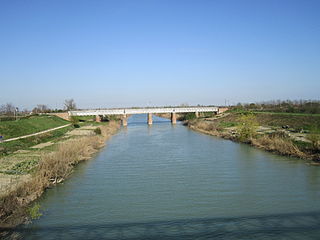
The Fiumi Uniti is a river in the province of Ravenna in the Emilia-Romagna region of Italy. The source of the river is the confluence of the rivers Montone and Ronco south of Ravenna. The river flows east 12 kilometers before entering the Adriatic Sea south of Lido Adriano.

The Rabbi is a river in the Tuscany and Emilia-Romagna regions of Italy. The source of the river is in the Foreste Casentinesi, Monte Falterona, Campigna National Park in the Appennino Tosco-Emiliano mountains in the province of Florence. The river crosses the border into the province of Forlì-Cesena and flows northeast near Premilcuore and Predappio before joining the Montone near Forlì.
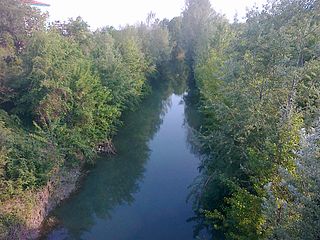
The Lamone is a river in the Tuscany and Emilia-Romagna regions of Italy. The source of the river is in the Appennino Tosco-Emiliano mountains in the province of Florence. The river flows northeast near Marradi before crossing the border into the province of Ravenna. It continues flowing northeast near Brisighella, Faenza, Russi and Bagnacavallo before curving eastward north of Ravenna and entering the Adriatic Sea near Marina Romea and Marina di Ravenna.

The Samoggia is a river in the Emilia-Romagna region of Italy. The source of the river is in the province of Modena near Zocca. The river flows northeast into the Metropolitan City of Bologna and flows near Bazzano, Crespellano, Piumazzo, Anzola dell'Emilia and San Giovanni in Persiceto before entering the Reno east of Decima. The Samoggia has a tributary called the Lavino that flows into it near San Giovanni in Persiceto.
The following is a timeline of the history of the city of Forlì in the Emilia-Romagna region of Italy.



















